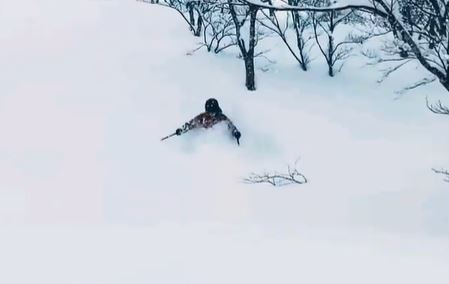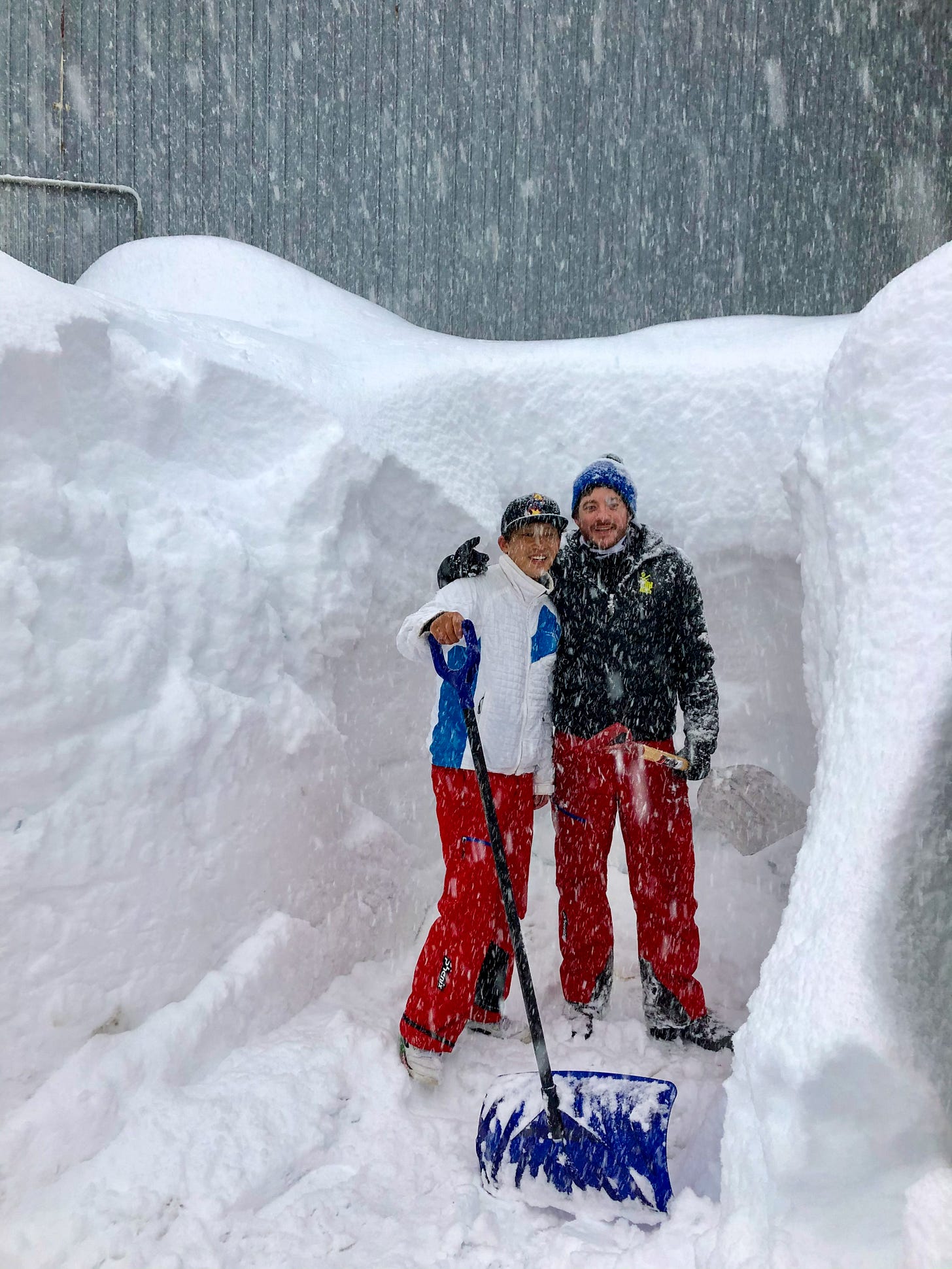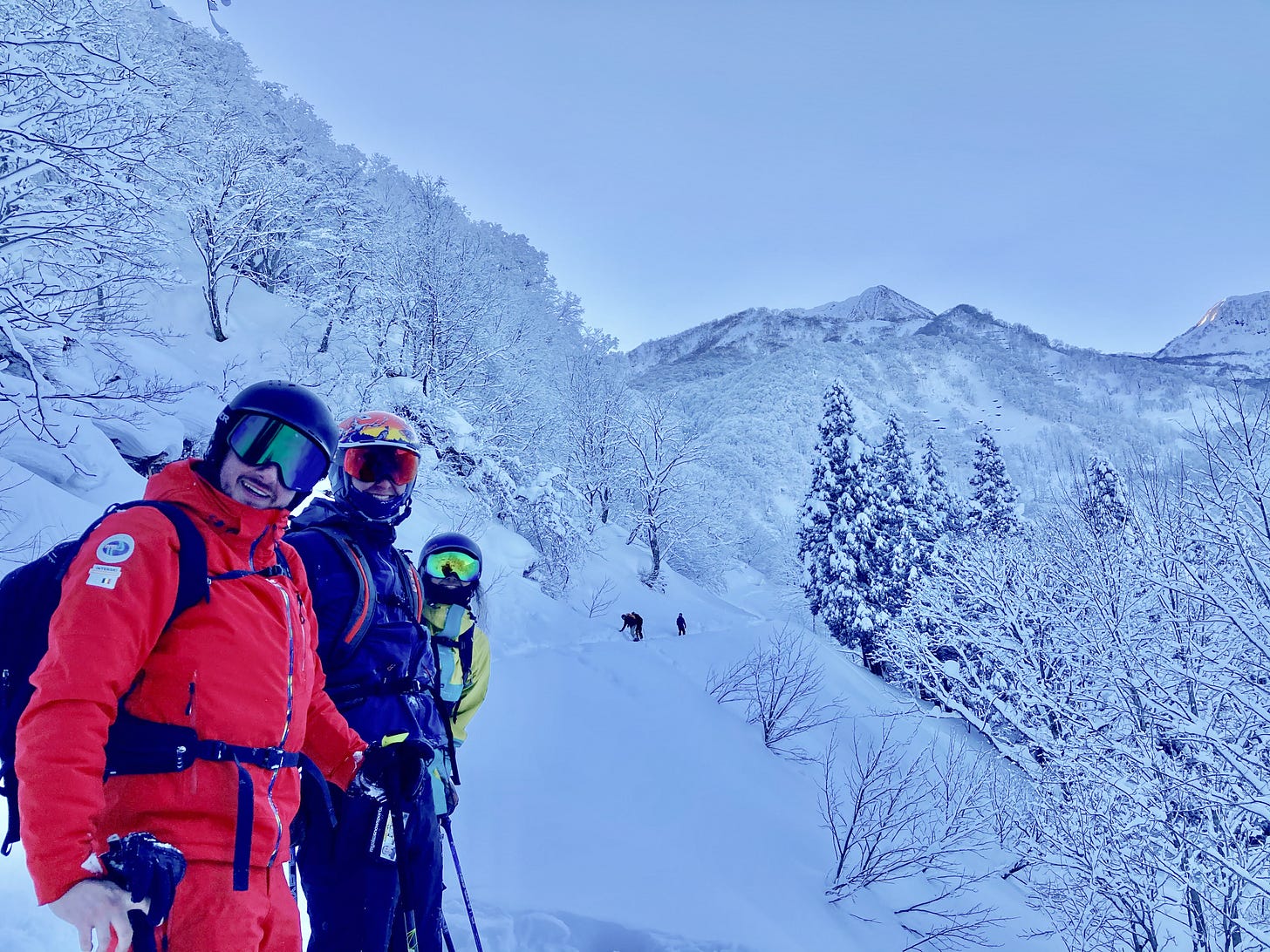Nothing beats skiing in 3D, try these tips to boost your confidence as a powder skier!
Time to level up and become a freeride-ninja!
During my second season as a ski instructor in Japan, I was lucky enough to experience a record twenty-two metres snowfall season in Myoko.
Twenty-two metres is absolutely batshit-crazy!
By comparison, in general, the average cumulative snowfall per season is between five and eight metres in the northern Alps of Europe.
Why is it that so much snow can fall during a Japanese winter?
Japan is famous for having some of the best powder skiing conditions in the world, renowned for its quality and quantity of snow each season. Many skiers visit Japan for this reason, as it provides an experience unlike any other with the vast amounts of snow found in the region.
The weather systems that move across the Sea of Japan from Siberia are responsible for most of the snowfall experienced by Japan ski resorts each year. These weather systems dump an average 10 to 20 metres worth of snow every season, providing a deep and consistent blanket making skiing experiences all over Japan unique. Many skiers describe it as 'the ultimate powder experience' given how light and dry the powder can be at times.
Me enjoying some deep powder snow in Myoko, Japan.
The sheer amount of terrain available to explore in different types of conditions also makes skiing in Japan attractive to those seeking off-piste adventures in challenging conditions. Deep powder slopes can often be found on sides of mountains that are far away from regular ski routes, perfect for those looking to embark on exciting back country missions. In addition, some areas offer some steep tree-runs which provide fun challenges for more advanced skiers.
One thing that sets Japanese resorts apart from others is its high-level focus on safety regulations and its exceptional customer service standards. With increased safety precautions against avalanches such as avalanche control zones (which involve explosives) being used throughout ski areas, it gives skiers even more peace of mind when looking to explore different sections while still having a good sense of security knowing they’re protected if anything goes wrong.
This combined with experienced staff members monitoring the mountains daily allows riders to enjoy their time without worrying too much about potential dangers ahead - something that should be taken into consideration when comparing different ski locations around the world!
This is what I, personally, remember most from my experience with heavy snowfall in the mountains of Japan:
Getting up early every day to clear snow before heading off to work…
Digging your car out of the snow after a day of teaching…
Clearing all the snow again on the driveway when returning home…
Clearing snow from the roof of your guest house…
Clearing some more snow from the roof…
Clearing snow, clearing snow, and then clearing even more snow again...
In other words, by then I had become a full-time snow shoveller. This much snow comes with consequences, right? 😉
Besides stronger shoulders, I did also gain a lot of experience in skiing deep powder during that season.
My homie Kim and myself, shovelling snow on our driveway.
How to gain more confidence skiing powder?
Powder skiing is exciting because you are usually moving off-piste, and your feet are mostly hidden under the deep snow during the action (so you cannot see what is happening).
For me, there are two dimensions to building confidence in powder skiing. There is always a safety dimension, and a technical dimension.
To feel confident while freeriding, we want to minimise fear and maximise confidence in our safety. So, you need to prepare well, and respect safety rules.
On the other hand, powder skiing also requires you to be a technically proficient skier, able to adapt your technique according to conditions. You need to become confident about your abilities.
The more technically proficient you are, the lower the risk also becomes of injury or misjudgement. So, these two dimensions certainly overlap to some extent as well.
Let's zoom in on the safety dimension first.
How to maximise safety while powder skiing
Powder skiing is an exhilarating experience, and one that should be enjoyed responsibly. To ensure a safe and enjoyable powder ski outing, here are some important safety guidelines to keep in mind.
Wear protective gear
Make sure to wear all the necessary protective gear, such as helmets, goggles and back protectors. Additionally, it is important to dress appropriately for the weather conditions - opt for waterproof layers and cold-weather clothing, including a face mask or balaclava.
Always prepare yourself in advance + carry equipment
Before embarking on any powder skiing expedition, it is important to assess the environment for potential hazards. Take note of any changing weather conditions like heavy snowfall or strong winds that might require you to adjust your route accordingly.
Additionally, pay attention to avalanche areas and take precautions such as carrying a transceiver, shovels and probes with you in case of emergencies. School yourself on avalanche equipment if you know too little about this, and take an avalanche course.
Don't overestimate your capabilities
Powder skiing can be dangerous if not done correctly. Be aware of your own skill level and don’t push yourself too far outside your comfort zone - start small then work your way up gradually.
If you’re ever unsure about the terrain or conditions ahead, the best thing you can do is take your time and err on the side of caution until you gain more experience.
Provide the right ski equipment
Fat skis provide an accessible powder skiing experience. It’s important that your skis are sufficiently wide underfoot. You want something wider than your boot.
It’s always best to opt for a pair of skis with tip rocker, which means you need less mental and physical strength to get the tip above the snow when skiing downhill.
Specific back country ski boots also help, as well as powder poles with wider rondelles (which improve grip in deeper snow).
No friends on a powder day? Think again…
Never ride alone. Powder skiing is best enjoyed with friends who are also competent and experienced. Going for a ride together makes the whole thing a lot safer!
Always consider hiring a professional guide, someone who knows the area very well. Your safety is well worth the money.
Expect the best, prepare for the worst
And last but not least: always be prepared for emergencies. You should always carry essential supplies with you when skiing off-piste such as basic first aid items and food & water – these may be helpful during long skiing days or if unexpected problems arise.
Additionally, make sure someone knows where you intend to go, so they can alert emergency services if needed.
Following these safety guidelines will help ensure that your powder skiing experience is safe and enjoyable!
Always respect safety when powder skiing, and ride with experienced friends. It will make you feel confident about freeriding, and it also makes the experience much more fun!
Fundamentals of proper ski technique in powder
Powder skiing is a form of free skiing, but that doesn't make it any less technical. I like to call it skiing in 3D because besides forwards/backwards and left/right, your skis can also move up/down. This extra dimension calls for additional technical abilities.
To make the most of your time navigating through deep, soft snow, it’s important to understand the fundamentals of proper ski technique in powder:
Develop your ‘bounce’
To maximise your enjoyment of powder skiing, explore the feeling and sensation of a "bounce." When you find yourself on an ideal gradient with soft snow beneath your skis, envision it as if you are bouncing off a trampoline.
Push down into both feet while bending and stretch out the ankles, knees and hips - allowing for complete balance to be maintained throughout each bounce.
The rebound effect created by this movement will cause that light "floaty" phase in addition to pushing further back up towards the surface again as gravity pulls downwards. Take time to feel these motions until they come naturally!
In the beginning, you will be able to create the 'bounce' mainly thanks to an aggressive extension/flexion movement.
Afterwards, you can refine this to a retraction/extension movement, where you allow the skis to pass underneath you by retracting the legs. You do need sufficient speed for this type of movement.
The idea behind both moves is that you create a platform of compressed snow against which to push off each time.
'The bounce' is the No. 1 move you should apply while powder skiing.
The ‘bounce’ = the holy grail of powder skiing.
Strong leg turning
In powder turns, you use your legs to steer much more than you use your edges to carve, like on groomed slopes.
Improve weight transfer & balance
Skiing on powder requires a different approach than skiing on groomed runs because of its softer and less predictable nature. To maintain balance, skiers must learn how to adjust weight distribution depending on the terrain they are skiing over and how fast they are going.
As with all skiing techniques, it’s important to keep your centre of gravity low while also keeping your body evenly balanced between both legs.
The ability to quickly transfer weight from one foot to another as needed is essential for navigating through soft snow without losing control or balance.
Opt for a narrow stance
In powder, skis should also be kept close together. This facilitates floating on the snow and makes it easier to spread your weight over both feet, thus further improving your lateral balance.
Calibrate turn radius & angle
It’s important to remember that wide turns will cause the skis tips to sink into the snow, making it much harder (and slower) to turn.
Another key factor is the angle of your lower legs—skiers should try keeping their legs parallel during turns as this will help minimise sinking into the snow and keep them steady during each turn.
Manage edge control & pressure distribution
When it comes to edge control in powder, applying pressure evenly across both skis is essential for maintaining speed and direction while reducing your risk of slipping or falling out of control.
By tipping both edges simultaneously, you can create more tension in your ski base which will help keep you steady during each turn and allow you to move confidently around obstacles like rocks or trees without sacrificing speed or accuracy.
Make speed your friend
When skiing in deep powder, it is best not to ski too slowly. The slower you ski, the more you give the skis a chance to sink into the snow again. This is why you don't want to oversteer your turns.
Too much steering will make your turn transitions more difficult because you won't have enough speed left to 'pop' out of the snow via the 'bounce'.
Work on your skiing skills on easier terrain first if you are not yet confident enough to ski fast off-piste.
Adjust your rhythm to the circumstances
You can further improve your powder skiing technique by finding a rhythm that creates the gentle bouncing effect of an imaginary trampoline underfoot.
As you approach a turning point, gently tip and steer your skis into a C-shaped arc to initiate a turn.
While developing this coordination between tipping, steering and rhythmic bounce may take practice, doing so will give you more control on powdery surfaces for greater enjoyment out in nature's winter playground!
Think about where you stop
Definitely don't stop on flat terrain! Your skis will sink into the snow, and it will be difficult to get going again because the snow offers resistance.
Always stop somewhere where the angle of slope is big enough, so you can get back up to speed quickly when you allow yourself to slide into the fall line once again.
Wield a powerful pole plant
Whether you’re a novice skier or an experienced one, powder skiing should be all about smooth and rhythmic turns. Try timing your pole plants to create balance while making each turn - they'll act as markers at the end of every transition!
Conclusion:
Powder skiing is an exhilarating experience, but can be intimidating if safety precautions are not respected and proper technique is not mastered yet.
To make the most of your time on & off the slopes this season, it is best to focus on maximum safety and becoming proficient in essential movements.
With practice and patience, you'll be carving through fresh pow like a pro in no time!
Keep an eye on your inbox the following weeks because I'm kicking off the new year with an article on the most common mistakes you can make while powder skiing.
Happy holidays! Let it snow, let it snow, let it snow…
Consider giving me a small tip if you enjoyed my work over the past year…
Check out my video tutorial on carve skiing! 👇









